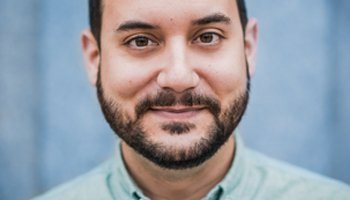.jpg?width=375)
Following his keen understanding of both programming and design, Jayce found his way to Guerrilla as Technical Designer to help teams implement their vision.
Jayce shares his knowledge of technical design, the process for helping several game teams, and shares tips for those interested in pursuing this unique discipline!
Hi Jayce! Thanks for taking the time to chat with us today. Before we get into everything technical design, tell us about yourself!
Hello! I was born and raised here in Amsterdam, but have been living in Zaandam since 2016. I studied Gaming Art at Media College Amsterdam and Game Design and Development at Utrecht School of the Arts, where I focused on flash development using Flash, Unity and Unreal Engine 4. Before I came to Guerrilla, I was at Turtleneck Studios and Little Chicken Game Company and Media.Monks.
Outside of schooling and work, I love sim racing, (aggressive) inline skating, bowling, going out for ramen and Korean BBQ, building model kits like gunpla – and I used to dance!
Wow - you have so many different hobbies! How did you get into some of them?
I grew up with inline skating and I love the freedom of movement and being able to do tricks. I skate through Amsterdam, which can be dangerous because of the combination of pedestrians, bikes, motorcycles, cars, buses, trams and even trucks! I often go to skate parks or just go out and skate through the city to enjoy the freedom.
I got into dance because my cousins and I used to copy dance moves from music videos on TV when we were little. That’s how I grew to dance hip hop, house, and popping and locking. As we got older, we started following choreographers for these dances and created dance covers for them. One choreographer we admired saw one of our videos and tweeted about it! It was amazing to be seen by someone who we looked up to.
With so many different hobbies and interests you had, what made you want to pursue technical design when it came to your career?
Originally, I applied to Guerrilla as a Programmer because I thought this was what I wanted to do. When I was interviewing with Guerrilla, they suggested that the Technical Designer role might suit me better. But at the time, I had no clue what a Technical Designer did and wasn’t sure if I was the right person for that role! But I decided to go on with the interviews for that role and see if it was right for me. I got the job and have been here as a Technical Designer since (April 1st, 2019 – and no, this isn’t an April Fool’s joke).
I really like working closely with the team creating the game, helping them with their technical issues and coming up with creative solutions – not just for the short term, but for the long-term, working with several teams on the best approaches for improving the workflow and pipeline of Quest Designers.
The moral of this story: apply for the job, even if you think you might not be right for it!
And good thing you decided to go for it, too! What’s life at Guerrilla been like since?
Ever since I joined, I felt welcome by everyone here at the studio. I can easily go to anyone with questions and everyone’s always willing to help or explain to me how something works so that I can share the knowledge with other teams.
It goes the other way around, too. When programmers have something new that might be useful, they share it with me or keep me in the loop of what’s coming up. I like to be in the loop during creation of a new system/feature so I can help think about how designers would use it, so I really appreciate this.
If I have something big to work on, I spend some time investigating existing tools to see what I can build out of that and then write proposals to leads and teams to see what route to take. But we don't always talk about work – we also talk about stuff we share interest in and we often do team outings. I love that there’s so many activities you can do outside of work with Guerrillas. A few of my favorite activities are team dinners and whenever we discuss motorsport and skating!
Technical design could seem like a very niche discipline, especially to people who aren’t familiar with the gaming industry. How do you explain what it is to someone who doesn’t know a lot about video games?
A lot of friends and family ask this question, and I usually explain it this way: I’m like a help desk for the Quest team. They come to me with a design topic they have trouble implementing, along with existing tools they can use. I investigate the missing piece: first, I see if it can be resolved without any code changes by seeing if something can be made into a reusable Lego block, so the designer wouldn’t have to do these steps manually. If there’s no easy solution, I talk with other departments to see if there are other ways to resolve this.
On the flip side, programmers also often come to me if they want to do X or Y. They want to know if those changes will impact anything in design or if they created new features that might be useful for designers, which I share with the design teams. I act as a bridge between designers and programmers, and due to my background in programming and designing I know how to translate it to the right department.
Along with short-term solutions, I also look ahead to see how a solution like this can be fixed or prevented in the future for other scenarios or systems. I need to know all the systems a Quest Designer uses before I can help them with their cases.
Since you juggle a lot in technical design, what makes it a particularly challenging role?
The most challenging part, but simultaneously also the most rewarding, is when I find a solution to a problem that will not only fix a bug but can be applied to other instances (often called a global issue and not tied to a specific content/area).
A global issue doesn’t always necessarily mean a problem, but could also be something that may lead into new possibilities that weren't considered before and can help create new features to the game. A pitfall for this is that it can take a lot of time to investigate and requires you to talk to several departments to find the potential solution.
Another challenging part of the job is trying to think of every single possible issue a designer can face and to think of a solution for that. Of course, not everything is dependent on me – but as a person who has a clear overview of what a designer does, it helps to be integrated with the team.
I really enjoy tasks that have me ask, how many times is X being used in the content and if we change it, how will it affect Y? Often, I don't have the answer to it directly, but after investigating I’m always happy to share the results with the teams.
So technical design requires a lot of foresight, but also the freedom to think through various situations? Is there a part in Horizon Forbidden West particularly where we can see the impact of your work?
You may not be able to see my work visually in-game, but I help with many things behind the scenes. Here are two scenarios in Horizon Forbidden West where I helped:
- If the player starts three main quests at the same time and they must complete all three that can be completed in any order before they continue with the next main quest – specifically: The Broken Sky, The Sea of Sands, and Seeds of the Past. At some point in the game, the player talks to GAIA and can choose the route they want to do first to acquire an AI kernel. This wasn’t something Guerrilla had implemented before, so it was quite unique to set up this scenario.
- If you start the game for the first time, the player will see an intro cinematic where Aloy travels the world, goes from location to location – and this is all done using real-time rendering! This means that the cinematic was not pre-rendered and re-played as a video, but calculated and executed per frame using our in-engine tech. This was quite a technical challenge to pull off with the hardware. Thanks to the combined collaboration between designers, the cinematics team, game code and game tech teams, we pulled this one off to a fantastic result!
I know we haven’t been able to go as deeply into technical design as we could’ve, but what are some things a beginner could do to start their craft as a technical designer?
I suggest trying to design a small game or in our case, a quest without doing additional programming and see how far you can get (i.e. Unreal Engine Blueprints). Once you can't think of how to do X or Y, see what you need to change in code C++ and how that’d affect your design. This will give you an idea of what you can do as a designer and what you can do as a programmer. Try to see if you can create an interactive object that can be re-used for various scenarios, or a re-used compound of Lego blocks so designers don’t have to repeat all those steps.
This will help you understand the systems that designers have to use and how programmers build those systems – and where you, a Technical Designer, can come in to bridge the gap. It’s up to you to understand each expertise and ask how you can get the most out of the two disciplines.
Are there any specific things you’d recommend when it comes to either programming or game design, since understanding both is crucial?
Try to be open to other scripting languages like Python. Unreal Engine, with Python, can create scripting to do things like finding out how many times an object is used – or to do something more extensive, like creating objects and assigning the right values and running the script for more possibilities.
If you want to help a designer, always ask what kind of experience they want to create. It might be that what they built might not be the best solution to the experience they want to create. Ask them what they’ve tried to do so far, so you can understand their way of thinking, before you can come up with a solution.
Never learn or teach stuff to yourself (or to others) answering, "That is the only way to go.” Learn WHY it must be done in this way, so you’re also able to teach WHY a designer has to implement it like that. Explain so they understand the reason behind it and that can be used in their own design decision process.
And as a final thought: never be afraid to make mistakes! Not everything you do will never be right at the start. You’ll likely experiment with various methods until you find something that works!



